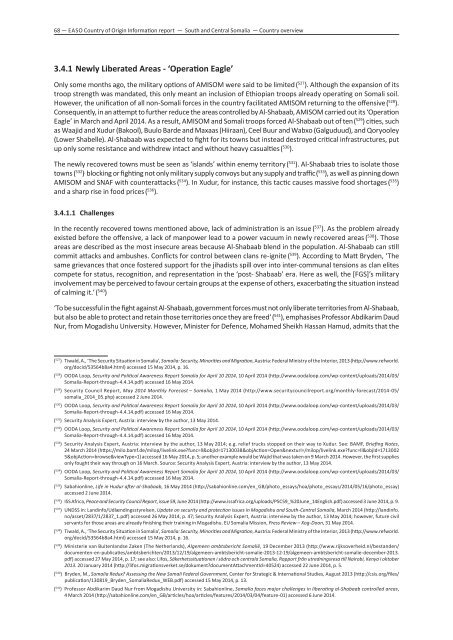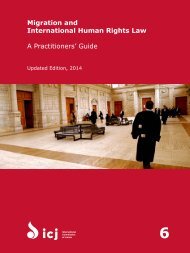Create successful ePaper yourself
Turn your PDF publications into a flip-book with our unique Google optimized e-Paper software.
68 — EASO Country of Origin Information report — South and Central <strong>Somalia</strong> — Country overview<br />
3.4.1 Newly Liberated Areas - ‘Operation Eagle’<br />
Only some months ago, the military options of AMISOM were said to be limited ( 527 ). Although the expansion of its<br />
troop strength was mandated, this only meant an inclusion of Ethiopian troops already operating on Somali soil.<br />
However, the unification of all non‐Somali forces in the country facilitated AMISOM returning to the offensive ( 528 ).<br />
Consequently, in an attempt to further reduce the areas controlled by Al‐Shabaab, AMISOM carried out its ‘Operation<br />
Eagle’ in March and April 2014. As a result, AMISOM and Somali troops forced Al‐Shabaab out of ten ( 529 ) cities, such<br />
as Waajid and Xudur (Bakool), Buulo Barde and Maxaas (Hiiraan), Ceel Buur and Wabxo (Galguduud), and Qoryooley<br />
(Lower Shabelle). Al‐Shabaab was expected to fight for its towns but instead destroyed critical infrastructures, put<br />
up only some resistance and withdrew intact and without heavy casualties ( 530 ).<br />
The newly recovered towns must be seen as ‘islands’ within enemy territory ( 531 ). Al‐Shabaab tries to isolate those<br />
towns ( 532 ) , blocking or fighting not only military supply convoys but any supply and traffic ( 533 ), as well as pinning down<br />
AMISOM and SNAF with counterattacks ( 534 ). In Xudur, for instance, this tactic causes massive food shortages ( 535 )<br />
and a sharp rise in food prices ( 536 ).<br />
3.4.1.1 Challenges<br />
In the recently recovered towns mentioned above, lack of administration is an issue ( 537 ). As the problem already<br />
existed before the offensive, a lack of manpower lead to a power vacuum in newly recovered areas ( 538 ). Those<br />
areas are described as the most insecure areas because Al‐Shabaab blend in the population. Al‐Shabaab can still<br />
commit attacks and ambushes. Conflicts for control between clans re‐ignite ( 539 ). According to Matt Bryden, ‘The<br />
same grievances that once fostered support for the jihadists spill over into inter‐communal tensions as clan elites<br />
compete for status, recognition, and representation in the ‘post- Shabaab’ era. Here as well, the [FGS]’s military<br />
involvement may be perceived to favour certain groups at the expense of others, exacerbating the situation instead<br />
of calming it.’ ( 540 )<br />
‘To be successful in the fight against Al‐Shabaab, government forces must not only liberate territories from Al‐Shabaab,<br />
but also be able to protect and retain those territories once they are freed’ ( 541 ), emphasises Professor Abdikarim Daud<br />
Nur, from Mogadishu University. However, Minister for Defence, Mohamed Sheikh Hassan Hamud, admits that the<br />
( 527 ) Tiwald, A., ‘The Security Situation in <strong>Somalia</strong>’, <strong>Somalia</strong>: Security, Minorities and Migration, Austria: Federal Ministry of the Interior, 2013 (http://www.refworld.<br />
org/docid/53564b8a4.html) accessed 15 May 2014, p. 16.<br />
( 528 ) OODA Loop, Security and Political Awareness <strong>Report</strong> <strong>Somalia</strong> for April 10 2014, 10 April 2014 (http://www.oodaloop.com/wp‐content/uploads/2014/03/<br />
<strong>Somalia</strong>‐<strong>Report</strong>‐through-4.4.14.pdf) accessed 16 May 2014.<br />
( 529 ) Security Council <strong>Report</strong>, May 2014 Monthly Forecast – <strong>Somalia</strong>, 1 May 2014 (http://www.securitycouncilreport.org/monthly‐forecast/2014-05/<br />
somalia_2014_05.php) accessed 2 June 2014.<br />
( 530 ) OODA Loop, Security and Political Awareness <strong>Report</strong> <strong>Somalia</strong> for April 10 2014, 10 April 2014 (http://www.oodaloop.com/wp‐content/uploads/2014/03/<br />
<strong>Somalia</strong>‐<strong>Report</strong>‐through-4.4.14.pdf) accessed 16 May 2014.<br />
( 531 ) Security Analysis Expert, Austria: interview by the author, 13 May 2014.<br />
( 532 ) OODA Loop, Security and Political Awareness <strong>Report</strong> <strong>Somalia</strong> for April 10 2014, 10 April 2014 (http://www.oodaloop.com/wp‐content/uploads/2014/03/<br />
<strong>Somalia</strong>‐<strong>Report</strong>‐through-4.4.14.pdf) accessed 16 May 2014.<br />
( 533 ) Security Analysis Expert, Austria: interview by the author, 13 May 2014; e.g. relief trucks stopped on their way to Xudur. See: BAMF, Briefing Notes,<br />
24 March 2014 (https://milo.bamf.de/milop/livelink.exefunc=ll&objId=17130038&objAction=Open&nexturl=/milop/livelink.exefunc=ll&objId=1713002<br />
5&objAction=browse&viewType=1) accessed 16 May 2014, p. 5; another example would be Wajid that was taken on 9 March 2014. However, the first supplies<br />
only fought their way through on 16 March. Source: Security Analysis Expert, Austria: interview by the author, 13 May 2014.<br />
( 534 ) OODA Loop, Security and Political Awareness <strong>Report</strong> <strong>Somalia</strong> for April 10 2014, 10 April 2014 (http://www.oodaloop.com/wp‐content/uploads/2014/03/<br />
<strong>Somalia</strong>‐<strong>Report</strong>‐through-4.4.14.pdf) accessed 16 May 2014.<br />
( 535 ) Sabahionline, Life in Hudur after al‐Shabaab, 16 May 2014 (http://sabahionline.com/en_GB/photo_essays/hoa/photo_essays/2014/05/16/photo_essay)<br />
accessed 2 June 2014.<br />
( 536 ) ISS Africa, Peace and Security Council <strong>Report</strong>, issue 59, June 2014 (http://www.issafrica.org/uploads/PSC59_%20June_14English.pdf) accessed 3 June 2014, p. 9.<br />
( 537 ) UNDSS in: Landinfo/Udlændingsstyrelsen, Update on security and protection issues in Mogadishu and South‐Central <strong>Somalia</strong>, March 2014 (http://landinfo.<br />
no/asset/2837/1/2837_1.pdf) accessed 26 May 2014, p. 47; Security Analysis Expert, Austria: interview by the author, 13 May 2014; however, future civil<br />
servants for those areas are already finishing their training in Mogadishu. EU <strong>Somalia</strong> Mission, Press Review – Xog‐Doon, 31 May 2014.<br />
( 538 ) Tiwald, A., ‘The Security Situation in <strong>Somalia</strong>’, <strong>Somalia</strong>: Security, Minorities and Migration, Austria: Federal Ministry of the Interior, 2013 (http://www.refworld.<br />
org/docid/53564b8a4.html) accessed 15 May 2014, p. 16.<br />
( 539 ) Ministerie van Buitenlandse Zaken (The Netherlands), Algemeen ambtsbericht Somalië, 19 December 2013 (http://www.rijksoverheid.nl/bestanden/<br />
documenten‐en‐publicaties/ambtsberichten/2013/12/19/algemeen‐ambtsbericht‐somalie-2013-12-19/algemeen‐ambtsbericht‐somalie‐december-2013.<br />
pdf) accessed 27 May 2014, p. 17; see also: Lifos, Säkerhetssituationen i södra och centrala <strong>Somalia</strong>, Rapport från utredningsresa till Nairobi, Kenya i oktober<br />
2013. 20 January 2014 (http://lifos.migrationsverket.se/dokumentdocumentAttachmentId=40524) accessed 22 June 2014, p. 5.<br />
( 540 ) Bryden, M., <strong>Somalia</strong> Redux Assessing the New Somali Federal Government, Center for Strategic & International Studies, August 2013 (http://csis.org/files/<br />
publication/130819_Bryden_<strong>Somalia</strong>Redux_WEB.pdf) accessed 15 May 2014, p. 13.<br />
( 541 ) Professor Abdikarim Daud Nur from Mogadishu University in: Sabahionline, <strong>Somalia</strong> faces major challenges in liberating al‐Shabaab controlled areas,<br />
4 March 2014 (http://sabahionline.com/en_GB/articles/hoa/articles/features/2014/03/04/feature-01) accessed 6 June 2014.



